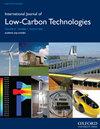燃料电池与太阳能相结合的煤气化电厂污染物减排工艺的开发与研究
IF 2.3
4区 工程技术
Q3 ENERGY & FUELS
引用次数: 0
摘要
尽管煤炭是化石燃料中资源最丰富的,但燃煤电厂向大气中排放了大量的温室气体。在这方面,减少燃煤造成的环境挑战和危机可能是减少当今能源领域危机的一个有希望的选择。燃煤电厂与可再生能源系统的整合可以同时改善热力学性能并降低污染物排放率。本文介绍了一种新型燃煤电厂的热力学和污染物排放研究,该电厂采用线性菲涅耳太阳能集热器(LFSC)驱动的太阳能单元、抛物槽太阳能集热器(PTSC)驱动的太阳能单元、高温燃料电池堆(熔融碳酸盐燃料电池堆[MCFCS])和热回收系统(基于蒸汽轮机和燃气轮机的动力循环)。该工厂能够生产电力和热水。提供的工厂的主要结构是基于煤炭的,然而,与可再生能源循环相结合,以减轻对环境的影响。该电站可发电约207兆瓦,发电功率为3728立方米/小时。在此条件下,可实现73.1%的能源效率和44.18%的火用效率。此外,该工厂的气体排放量接近403吨/小时。并对不同类型煤(石油焦和无烟煤)下的电厂性能进行了全面比较。此外,还提出了一种双函数优化方法,以确定火用效率的最大值和总污染物排放率的最小值。本文章由计算机程序翻译,如有差异,请以英文原文为准。
Development and investigation of a pollutants emission reduction process from a coal-gasification power plant integrated with fuel cell and solar energy
Abstract Even though coal resources are the most abundant among fossil fuels, coal-fired plants release large amounts of greenhouse gases into the atmosphere. In this regard, reducing environmental challenges and crises caused by coal burning can be a promising option to reduce today's crises in the energy field. The integration of coal-fired plants with renewable-driven energy systems can simultaneously improve thermodynamic performance and reduce pollutants emission rates. This article presents the thermodynamic and pollutant emission investigations of a new coal-fired plant coupled with a linear Fresnel solar collector (LFSC)-driven solar unit, a parabolic trough solar collector (PTSC)-driven solar unit, a high-temperature fuel cell stack (molten carbonate fuel cell stack [MCFCS]) and a heat recovery system (based on the steam turbine and gas turbine-based power cycles). The plant is able to produce electricity and hot water (HW). The main structure of the offered plant is based on coal, whereas, is coupled with renewables-based cycles to mitigate environmental impacts. The plant could generate ~ 207 MW of power and 3728 m3/h of HW. In such conditions, the energy efficiency of 73.1% and exergy efficiency of 44.18% could be achievable. Further, the emitted gas rates of the plant were nearly 403 tons/h. A comprehensive comparison is also presented for the plant's behavior under different types of coal (petcoke and anthracite). In addition, a two-function optimization is developed to determine the maximum value of exergy efficiency and the minimum value of total pollutants emission rate.
求助全文
通过发布文献求助,成功后即可免费获取论文全文。
去求助
来源期刊

International Journal of Low-carbon Technologies
Engineering-Architecture
CiteScore
4.30
自引率
4.30%
发文量
106
审稿时长
27 weeks
期刊介绍:
The International Journal of Low-Carbon Technologies is a quarterly publication concerned with the challenge of climate change and its effects on the built environment and sustainability. The Journal publishes original, quality research papers on issues of climate change, sustainable development and the built environment related to architecture, building services engineering, civil engineering, building engineering, urban design and other disciplines. It features in-depth articles, technical notes, review papers, book reviews and special issues devoted to international conferences. The journal encourages submissions related to interdisciplinary research in the built environment. The journal is available in paper and electronic formats. All articles are peer-reviewed by leading experts in the field.
 求助内容:
求助内容: 应助结果提醒方式:
应助结果提醒方式:


